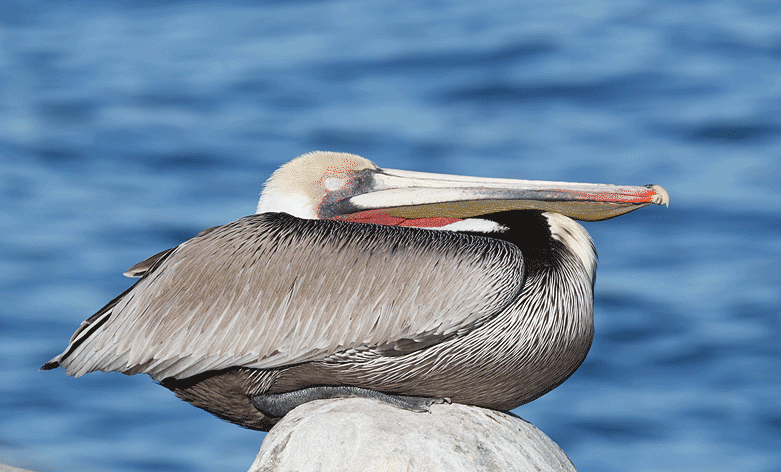| [Not a valid template] |
|
This Brown Pelican image was created in La Jolla, CA with the Canon EF 800mm f/5.6L IS lens and the EOS-1D Mark IV. ISO 400. Evaluative metering at zero: 1/2000 sec. at f/8. Early morning (8:53am) light. |
Why Wide Open Works Well For Me
When I posted the image above in yesterday’s blog post, Why 32-gb Flash Cards? Why Delkin e-film Pro?, I commented: “Note that at f/8 I have brought up a pleasing amount of background detail, but nothing too sharply defined.” (Note: wide open for the 800mm L IS lens is a relatively slow f/5.6; thus f/8 is stopped down one full stop from wide open.) My first in many situations is to work wide open or stopped down only 1/3 stop. With a Brown Pelican sitting on the edge of a cliff at LaJolla the background will be about 100 yards from the subject, even farther away if you get low. So stopping down from f/5.6 to f/8 still yielded a pleasing, relatively out-of-focus background. (For more on my usually preferred style, see Tight or Wide? My Thoughts on Photographic Style and More.)
If you plan on visiting San Diego next winter to photograph, getting yourself a copy of our San Diego Site Guide now will give you lots of time to study and learn all the great spots that we describe in detail. You can check out all of our great Site & Set-up Guides by clicking here.

|
When the pelican in the opening image went to sleep, I figured that it would be a good time to create some educational images so I created a series of photographs at varying apertures. In the animated GIF above, the image with the very soft, out-of-focus background was created wide open at f/5.6. The image that shows the wavelets defined relatively sharply was created at f/22. Of the two, which background do you prefer? Does the bird look any sharper at f/22 than it does at f/5.6?
My very great preference in this and in similar situations is to work wide open or stopped down no more than one stop. Doing so will yield the pleasingly out of focus backgrounds that I love so dearly and that define the BIRDS AS ART style. It is important to realize that this does not mean that this style is best for you….
For more examples of images created at varying apertures and their effects on the background, check out James Shadle’s excellent thread, How Aperture Selection Affects DOF and Background, in the Educational Resources Forum at BPN. (Note: if you are within driving distance of Tampa Bay it would behoove you to get out on the Hooptie Deux with James for a day or two on the bay with the Roseate Spoonbills asap. Click here for info.)
Shopper’s Guide
Below is a list of the gear that I used to create the images above. Thanks a stack to all who have used the Shopper’s Guide links to purchase their gear as a thank you for all the free information that we bring you on the Blog and in the Bulletins. Before you purchase anything be sure to check out the advice in our Shopper’s Guide.
Canon 800mm f/5.L IS lens. Right now this is my all time favorite super-telephoto lens.
Canon EOS-1D Mark IV professional digital camera body. The very best professional digital camera body that I have ever used.
And from the BAA On-line Store:
I’l be packing my 800 and tons of other gear in my ThinkTank Airport SecurityTM V2.0 rolling bag this afternoon for my flights to Hawaii tomorrow. I recommend that bag or the slightly smaller Airport InternationalTM V2.0 for most folks to make their air travel easy. These high capacity bags are well constructed and protect my gear when I have to gate check it on short-hops and puddle jumpers. Each will protect your gear just as well. By clicking on either link you will receive a free gear bag with each order over $50.
Gitzo GT3530LS Tripod. This one will last you a lifetime.
Mongoose M3.6 Tripod Head. Right now this is the best tripod head around for use with lenses that weigh less than 9 pounds. For heavier lenses, check out the Wimberley V2 head.
Double Bubble Leve.l You will find one in my camera’s hot shoe whenever I am on a tripod and not using flash.
Delkin 32gb e-Film Pro Compact Flash Card. These high capacity cards are fast and dependable.














Sorry, continuing earlier message. I have delkin 32 g sd cards on my xsi and my s90, with no problems.
Marvin
Wide open is much better in this case.
Arthur, you give such great info. On your blog….thank you, I am really enjoying reading it, and all of the links you give makes for even more fun! I like the w/o and think it is sharper.
Ditto on the WO!
Wide open is awesome!
I much prefer the wide open image. Having such a smooth, almost liquid background actually makes the bird detail appear sharper in the wide open shot.
Smooth, OOF background all the way for me in most cases. My primary exception is if I’m going for an environmental portrait.